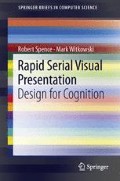Abstract
Certain features of the human visual processing system influence the success with which the technique of RSVP can be applied. First and foremost is the phenomenon of pre-attentive processing, supporting the recognition of a target image within about 100 ms and without conscious cognitive effort. But other factors, if ignored, can detract from the benefits of RSVP. They include change blindness and saccadic blindness. Other features of the human cognitive system that must be taken into account in any design involving RSVP include user memory and the concept of salience influencing how attention is directed.
Access this chapter
Tax calculation will be finalised at checkout
Purchases are for personal use only
Notes
- 1.
If you want to try this experiment go to www.csc.ncsu.edu/faculty/healey/PP/.
- 2.
The reader can experience attentional blink by accessing the website:
- 3.
Actual examples for change blindness can be experienced through the website
- 4.
A similar, and amusing episode can be experienced at
References
Chahine, G., & Krekelberg, B. (2009). Cortical contributions to saccadic suppression PlusOne, 4(9) (online).
Coltheart, V. (1999). Fleeting memories cognition of brief visual stimuli. Cambridge: MIT Press.
Diamond, M. R., Ross, J., & Morrone, M. C. (2000). Extraretinal control of saccadic suppression. The Journal of Neuroscience, 20–9, 3449–3455.
Erdmann, B., & Dodge, R. (1898). Psychologische Untersuchung über das Lesen auf experimenteller Grundlage. Niemeyer: Halle.
Findlay, J. M., & Gilchrist, I. D. (2003). Active vision: The psychology of looking and seeing. Oxford: Oxford University Press.
Healey, C. G., Booth, K. S., & Enns, J. T. (1996). High-speed visual estimation using pre-attentive processing. ACM Transactions on Human Computer Interaction, 3–2, 107–135.
Intraub, H. (1980). Presentation rate and the representation of briefly glimpsed pictures in memory. Journal of Experimental Psychology: Human Learning and Memory, 6, 1–12.
Intraub, H. (1981). Rapid conceptual identification of sequentially presented pictures. Journal of Experimental Psychology: Human Perception and Performance, 7, 604–610.
Intraub, H. (1984). Conceptual masking—the effects of subsequent visual events on memory for pictures. Journal of Experimental Psychology: Learning, Memory, and Cognition, 10, 115–125.
Intraub, H. (1999). Understanding and remembering briefly glimpsed pictures: Implications for visual scanning and memory. In V. Coltheart (Ed.), Fleeting memories: Cognition of brief visual stimuli. Cambridge: MIT Press.
Itti, L., & Koch, C. (2001). Computational modelling of visual attention. Nature Reviews, Neuroscience, 2, 194–203.
Kimron, L., Shapiro, K. L., & Luck, S. J. (1999). The attentional blink: A front-end mechanism for fleeting memories. In V. Coltheart (Ed.), Fleeting memories: Cognition of brief visual stimuli. Cambridge: MIT Press.
Kundel, H. L., & Nodine, C. F. (1975). Interpreting chest radiographs without visual search. Radiology, 116, 527–532.
McConkie, G. W., & Currie, C. B. (1996). Visual stability across saccades while viewing complex pictures. Journal of Experimental Psychology: Human Perception and Performance, 22–3, 563–581.
Nowell, L., Hetzler, E., & Tanasse, T. (2001). Change blindness in information visualization: A case study. IEEE Proceedings of Information Visualization.
Potter, M. C. (1975). Meaning in visual search. Science, 187, 965–966.
Potter, M. C. (1976). Short-term conceptual memory for pictures. Journal of Experimental Psychology-Human Learning and Memory, 2, 509–522.
Potter, M. C. (1999). Understanding sentences and scenes: The role of conceptual short-term memory. In V. Coltheart (Ed.), Fleeting memories: Cognition of brief visual stimuli. Cambridge: MIT Press.
Potter, M. C., & Levy, E. I. (1969). Recognition memory for a rapid sequence of pictures. Journal of Experimental Psychology, 81, 10–15.
Potter, M. C., Staub, A., Rado, J., & O’Connor, D. H. (2002). Recognition memory for briefly presented pictures: The time course of rapid forgetting. Journal of Experimental Psychology-Human Perception and Performance, 28, 1163–1175.
Raymond, J. E., Shapiro, K. L., & Arnell, K. M. (1992). Temporary suppression of visual processing in an rsvp task—an attentional blink. Journal of Experimental Psychology: Human Perception and Performance, 18, 849–860.
Rensink, R. A. (2000). The dynamic representation of scenes. Visual Cognition, 7, 17–42.
Rensink, R. A., O’Regan, J. K., & Clark, J. J. (1997). To see or not to see: the need for attention to perceive changes in scenes. Psychological Science, 8, 368–373.
Rensink, R. A., O’Regan, J. K., & Clark, J. J. (2000). On the failure to detect changes in scenes across brief interruptions. Visual Cognition, 7(1–3), 127–145.
Simons, D. J., & Levin, D. T. (1998). Failure to detect changes to people during a real-world interaction. Psychonomic Bulletin and Review, 5–4, 644–649.
Treisman, A. (1985). Pre-attentive processing in vision. Computer Vision, Graphics and Image Processing, 31, 156–177.
Treisman, A. (1991). Search similarity and integration of features between and within dimensions. Journal of Experimental Psychology: Human Perception and Performance, 17(3), 652–676.
Treisman, A., & Gormican, S. (1988). Feature analysis in early vision: evidence from search asymmetries. Psychological Review, 95–1, 15–48.
Ware, C. (2004). Information visualization: perception for design. Amsterdam: Morgan Kaufmann.
Witkowski, M., & Randell, D. A. (2007). A model of modes of attention and inattention for artificial perception. Bioinspiration and Biomimetics, 2, S94–S115.
Author information
Authors and Affiliations
Corresponding author
Rights and permissions
Copyright information
© 2013 The Author(s)
About this chapter
Cite this chapter
Spence, R., Witkowski, M. (2013). Experimental Evidence. In: Rapid Serial Visual Presentation. SpringerBriefs in Computer Science. Springer, London. https://doi.org/10.1007/978-1-4471-5085-5_2
Download citation
DOI: https://doi.org/10.1007/978-1-4471-5085-5_2
Published:
Publisher Name: Springer, London
Print ISBN: 978-1-4471-5084-8
Online ISBN: 978-1-4471-5085-5
eBook Packages: Computer ScienceComputer Science (R0)

